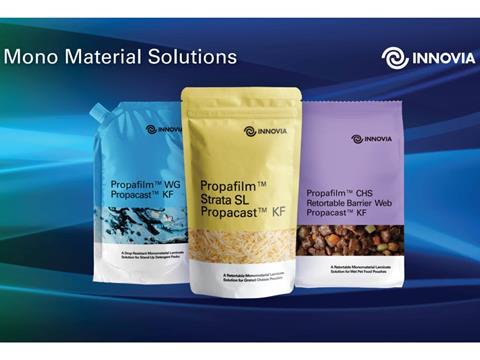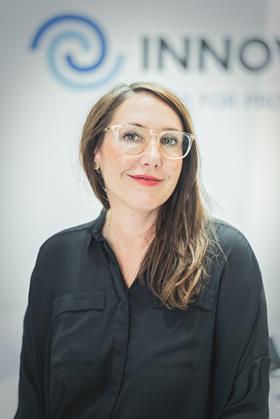
In this edition of our ‘In Conversation With…’ feature, Innovia’s Simon Huber, Managing Director Innovia Films Europe, and Marika Knorr, Head of Sustainability and Communication, share their views on the flexible packaging revolution and what we should expect to see in the future – including more mono-materials, recyclability, efficiency, and more.
How would you assess the current status of flexible packaging from a sustainability point of view?

MK: There have been tremendous activities and innovations in the past years to make flexible packaging more ‘recyclable’ and, more importantly, actually recycled. From mono-material structures to new recycling technologies, the packaging industry has got together across the whole value chain to drive change. This is pretty unprecedented.
Innovia Films joined CEFLEX (Circular Economy for Flexible Packaging) at an early stage to contribute our material science expertise. After all, we design the film material that later forms the basis for flexible packaging and labels – so we saw an obligation to contribute to the project.
Despite these activities, the fact remains that flexible packaging unfortunately still is not recycled on a large scale. That has several reasons, from collection systems to multiple laminate structures. We believe that this will be changed with the new Packaging and Packaging Waste Regulation that has been a hot topic for a while now!
Innovia is a materials science expert with many years of experience and we are dedicated to changing the flexible packaging world and to be the leader in tailormade mono-material PP solutions for our customers.
What effect do you think the EU’s PPWR is having, and what do you think the ultimate outcome for the flexibles industry will be?
SH: We can clearly see that our customers are taking action. PPWR is having a significant effect on the market in a positive way.
There has been talk now for several years around the need for ‘recyclable’ and ‘sustainable’ solutions and the directive from the EU is focusing minds on exactly what is needed and accelerating the speed of change. The key driver to realize the directive is the move to mono-material solutions that are fully recyclable.
In your view, what are some potential solutions for the issues raised by the market and legislative conditions we are currently seeing?
SH: A solution approach is essential to ensure we are able to offer packaging that is ultimately circular and closed-loop. The way to do this is for the manufacturers to understand the full structure of the packaging they are currently using, and for us to try to offer a solution that is fully mono-material.
Innovia is in a unique market position in that we can offer the full solution given our different technology assets – Bubble technology, Stenter, and Cast. Every single technology has different film properties, so we are able to select the film according to the customer’s needs and can offer the full range.
MK: Good examples would be PP mono-material pouch constructions that can replace polyamid, foil and mixed polymer constructions, which are hard to recycle and would not comply with the upcoming PPWR. Polypropylene is a great material to use for monomaterial pouches because it has a wide variety of applications and high barrier functions. It also helps to reduce the carbon footprint of packaging.
Another important pillar of the PPWR legislation is that packaging will have to contain a certain percentage of recycled content to drive a more circular economy. We are investing a lot in research and development and have set up a dedicated team that looks into recycling technology to make sure that Innovia has the right feedstock to make films with recycled content.
What is the importance of going above and beyond in terms of R&D in this context, both for packaging companies but also big brands?

SH: There has always been a need to look across all substrates in the packaging market. We have powerful capacities in research and development and are able to either further develop existing substrates or come up with something new.
Our core competencies are new product development, surface engineering, and polymer science, and we have dedicated teams for project delivery. A lot of investments are made to make sure that we have the latest laboratory equipment, which is necessary to come up with solutions that will revolutionize packaging.
Looking further ahead and thinking more from an environmental perspective, not just a commercial perspective, will ensure that the global and local brands are ensuring that the right solutions are offered to work towards lessening the negative impact that packaging can have on the planet.
Therefore, it is imperative that, as manufacturers, we really drive change that benefits the product in terms of shelf-life, brand integrity, and environmental impact. We are fully committed to doing that at Innovia with our products.
Looking ahead to the future – where do you think the flexible packaging industry is headed? What can it do to future-proof itself?
SH: Flexible packaging is without doubt being driven towards mono-material and, therefore, fully recyclable solutions.
MK: Flexible packaging deserves to have a bright future – and it will with material science excellence. It is lightweight and can be stacked and packed in an ideal way so the transportation is much lower from an emission standpoint compared to other packaging materials.
It is a durable packaging that doesn’t break easily – and, last but not least, offers 360-degree design and marketing opportunities which is, understandably, important to brands.
The bottom line is that we need to ensure that the products being introduced to the market solve the problem long term in terms of food waste, shelf life, and environmental impact – Innovia is a great development partner and solution provider for this. We have many years of expertise in developing film, can utilize different production technologies, and have unmatched research and development capacities with ultra-modern labs to solve challenges that brands are looking to overcome in their packaging.

















